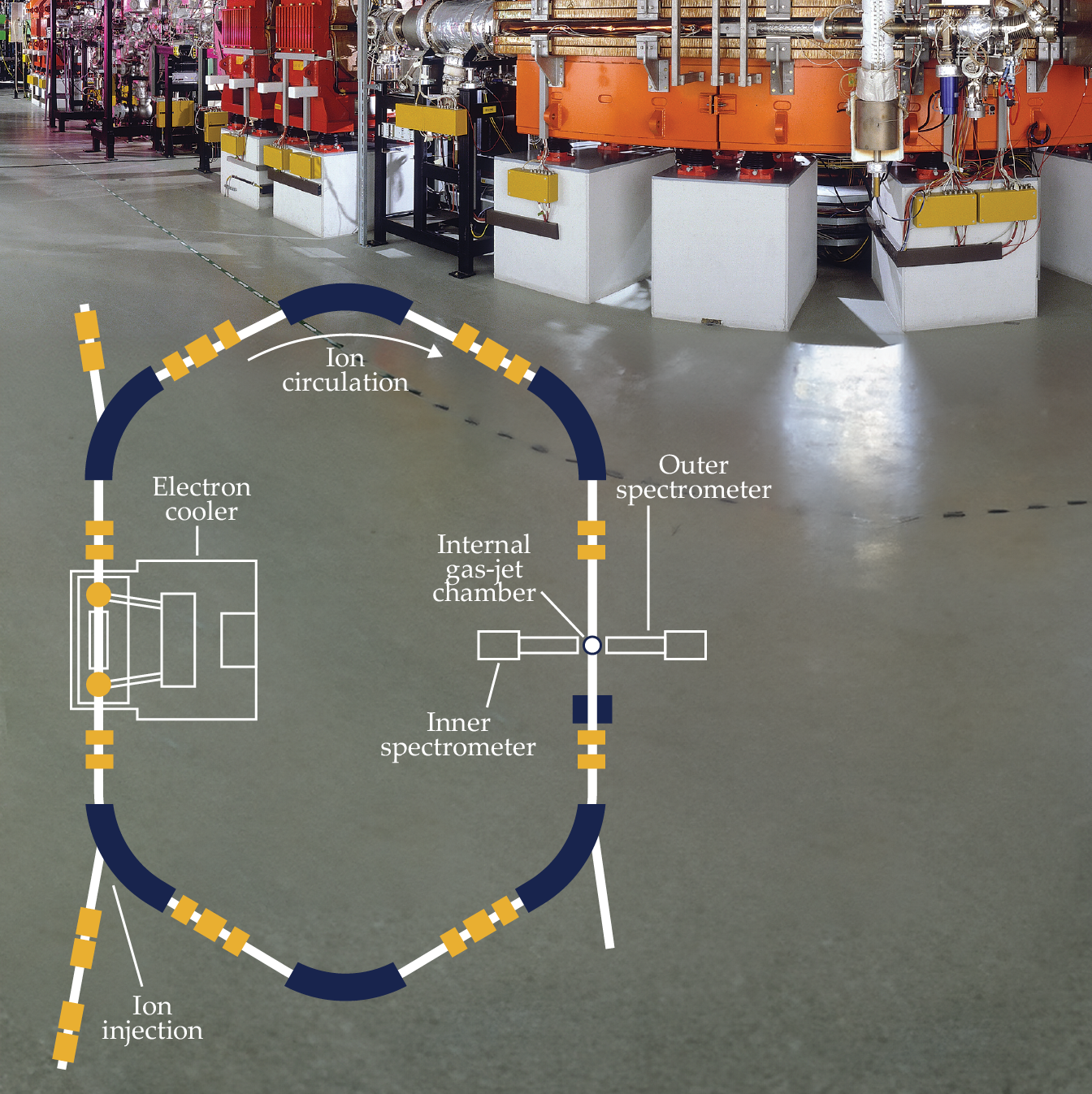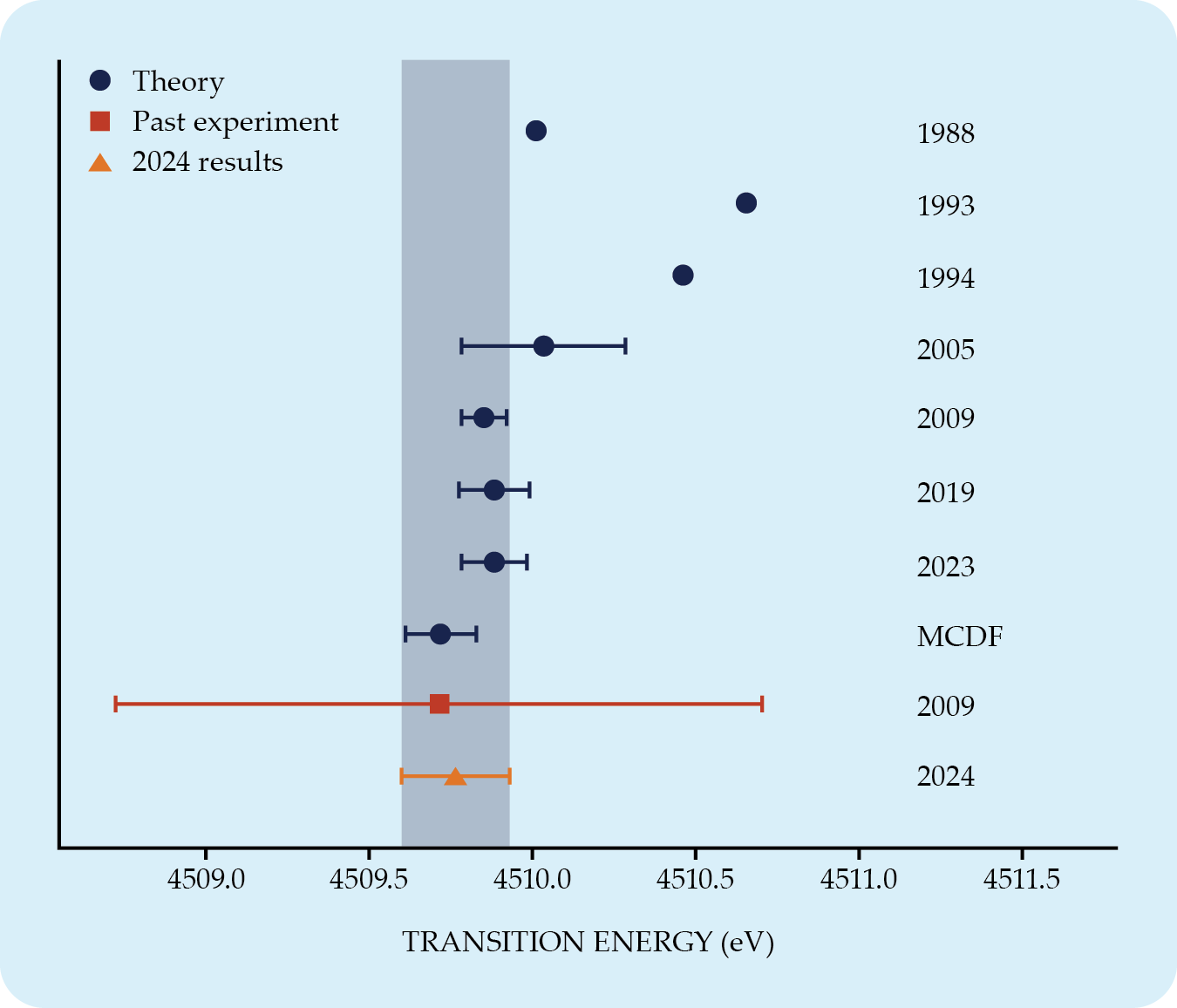Highly charged uranium tests the limits of quantum electrodynamics
DOI: 10.1063/pt.jcof.fxnv
When it comes to the most tested and precise scientific theories, quantum electrodynamics (QED) ranks at or near the top of the list. The theory of light–matter interactions has predicted, for example, the value of the electron’s magnetic dipole moment to 12 significant figures, and observations published last year are in agreement. 1 That’s equivalent to measuring the distance from New York City to Los Angeles to a precision better than the width of a human hair. 2 Yet despite QED’s superlative predictions, the theory is more readily validated in light atoms than in heavy atoms.
For low-mass atoms, perturbation theory can precisely predict QED effects, such as a slight change in the transition energy of an electron that’s decaying from an excited atomic orbital to a low-energy orbital. But in a high-mass atom, relativistic and QED effects cannot be well approximated as small disturbances to the system. That’s because such effects scale with Zα—where Z is the atomic number and α ≈ 1/137 is the fine structure constant. One can use nonperturbative methods to predict QED effects, and that’s been done for heavy atoms, such as uranium. 3 The problem is that the methods have yielded different calculations and aren’t as precise as perturbative approaches.
Previous efforts from 2009 to observe the transition energy of highly ionized uranium with x-ray spectroscopy weren’t precise enough to distinguish one calculation of QED effects in uranium from another. 4 Since then, advances have been made in predicting QED effects in heavy atomic systems and improving the experimental instrumentation. A team of 34 researchers, led by Martino Trassinelli of the CNRS in Paris and Robert Loetzsch of Germany’s Friedrich Schiller University Jena, now present transition-energy measurements in highly ionized uranium, and they’re precise enough to distinguish small QED effects in high-mass systems. 5
Uranium that comes around
Willis Lamb and Robert Retherford helped jump-start the field of QED with a 1947 experiment. They observed an unexpected energy difference—what became known as the Lamb shift—between the two lowest excited orbitals of the hydrogen atom, levels that existing predictions said should have the same energy. In response, researchers developed theoretical techniques to accurately account for the Lamb shift, which is a QED effect caused by the electron interacting with virtual photons.
Shortly after the discovery in the lightest atom, many began to wonder: How would the effects of QED change the behavior of an electron bound to uranium or another heavy element? Validations of QED over the past several decades have mostly been done in light atoms, but an experiment in highly ionized uranium could test for quantum effects in previously untested parameter space.
By the late 2000s, after decades of work, some theorists used nonperturbative methods to precisely calculate QED effects in heavy atoms with strong electric fields. 4 The advance set a challenging and motivational target for experimentalists: If x-ray spectroscopy measurements of an electron’s transition energy are precise enough, then QED effects in highly ionized uranium are observable.
Measuring a transition energy in a massive system like uranium demands a facility with a storage ring that can produce and hold a lot of ions. For experiments that test QED effects in heavy systems, the only place capable of meeting those requirements is the GSI Helmholtz Centre for Heavy Ion Research in Darmstadt, Germany. (The Heavy Ion Research Facility in Lanzhou, China, does offer similar capabilities, but the
intensity of its ion beam isn’t high enough to generate the necessary precision.)
At GSI, Trassinelli, Loetzsch, and colleagues ionized neutral uranium atoms and then sent the beam through a series of further ionization steps that accelerate it to near-relativistic speeds. More and more electrons are stripped from the nucleus until all that’s left is hydrogen-like uranium, U91+, with a single electron. Once decelerated and cooled to their ground state, the hydrogen-like uranium ions circulate in a vacuum in GSI’s experimental storage ring, as shown in figure
Figure 1.

The experimental storage ring at the GSI Helmholtz Centre for Heavy Ion Research in Darmstadt, Germany. Large, curved dipole magnets (blue in the schematic) steer highly ionized uranium in a vacuum around the ring, and other magnets (yellow) refocus the ion beam. On interacting with nitrogen at the gas-jet target, the uranium can take on different charge states, such as U90+, with two electrons. A pair of x-ray spectrometers measures an atomic transition that incorporates quantum electrodynamical effects in the highly charged system. (Photo courtesy of A. Zschau, GSI/FAIR; schematic adapted from ref.

A pair of x-ray spectrometers are positioned perpendicular to the gas-jet chamber to record the energy of photons emitted when one of the electrons decays from an excited 2p atomic orbital to a lower-energy 2s orbital. Out of all the possible transitions to measure that are sensitive to QED effects, that intrashell transition lies at an easily detectable energy. It has a 30% chance of occurring, and in the experiment, a spectrometer measures about one photon every three minutes.
In 2009 Trassinelli and his collaborators taking measurements at GSI had a single spectrometer and just three days of beam time to collect the observations.
4
The few hundred photons they observed weren’t enough to get the precision they were after. Another challenge was the large measurement error caused by the spectrometer’s imprecise viewing angle. For an accurate observation, the angle must be known to about a hundredth of a degree or better, but the uncertainty was about 0.4°. And the relativistic Doppler shift of the photon source and receiver added to the uncertainty, as shown in figure
Figure 2.

The transition energy of an electron decaying from the 2p atomic orbital to the 2s orbital was measured in 90-fold ionized uranium, a helium-like system with two electrons. A new measurement

Lowering uncertainties
Although the 2009 measurements did agree with predictions, the large experimental uncertainty meant that researchers couldn’t evaluate whether one theoretical approach was more accurate than another. Of that work, Trassinelli says, “it was a plan B sort of experiment, and we were a little bit frustrated.” So he and some colleagues began designing an improved experiment, and by the time the new measurements were taken in 2021, the team had made several changes to the design.
The researchers added a second spectrometer to collect more measurements. They also incorporated into the spectrometers high-quality curved germanium crystals. Loetzsch determined that they reflected incoming x-ray photons much more homogeneously than what was used in 2009.
Another improvement came in the form of a novel correction for the Doppler shift. In the storage ring, the team circulated the helium-like uranium, which, through electron capture in the gas-jet chamber, generated lithium-like and beryllium-like uranium. The spectral data from those charge states could then serve as additional reference lines for the Doppler-shift correction.
By improving the correction method and incorporating some previous spectral results, the researchers predicted that the precision of the spectrometer’s viewing angle could reach a resolution of 0.011°. In addition, GSI also improved the beam’s control system and upgraded its facilities in the intervening time (see Physics Today, November 2015, page 22
A hyperfine result
Loetzsch says that “the biggest challenge was getting beam time.” The facility’s upgrades made beam time an even more scarce resource than usual. So when the researchers finally got two weeks at GSI to collect observations, years after their initial request, they worked 24/7 with usually two people at a time controlling the experiment. After someone else’s experiment was canceled, the team got a third week to collect data. “The big question was if we could accumulate enough photons in the amount of time we had,” says Loetzsch. “So we were happy when we saw the first photons on the computer screen.”
After Loetzsch and colleagues collected the data and accounted for the Doppler shift and other known factors, they reported a transition energy of 4509.763 ± 0.166 eV, which, as figure
The new detailed measurements are already improving QED calculations. A few months ago, Aleksei Malyshev of St Petersburg State University and colleagues used the results to help calculate the transition energies for ionized uranium with one electron up to four electrons. 6 With measurements of four highly charged states, they compare predictions that include various QED effects, including electron–electron effects and nucleus-size contributions.
Upgrades to the experimental storage ring and the spectrometers could lead to about an order-of-magnitude improvement in the measurement’s precision. Increasingly precise transition-energy measurements may show evidence of higher-order QED effects, whose energy signatures are just a fraction of the one-loop and two-loop effects that have already been measured. The researchers aren’t sure yet whether the higher-order effects are observable in uranium or other heavy atoms.
References
1. X. Fan et al., Phys. Rev. Lett. 130, 071801 (2023). https://doi.org/10.1103/PhysRevLett.130.071801
2. R. P. Feynman, QED: The Strange Theory of Light and Matter, Princeton U. Press (1985).
3. V. A. Yerokhin, P. Indelicato, V. M. Shabaev, Phys. Rev. A. 77, 062510 (2008). https://doi.org/10.1103/PhysRevA.77.062510
4. M. Trassinelli et al., EPL 87, 63001 (2009). https://doi.org/10.1209/0295-5075/87/63001
5. R. Loetzsch et al., Nature 625, 673 (2024). https://doi.org/10.1038/s41586-023-06910-y
6. A. V. Malyshev, Y. S. Kozhedub, V. M. Shabaev, Phys. Rev. A. 107, 042806 (2023). https://doi.org/10.1103/PhysRevA.107.042806
More about the Authors
Alex Lopatka. alopatka@aip.org

